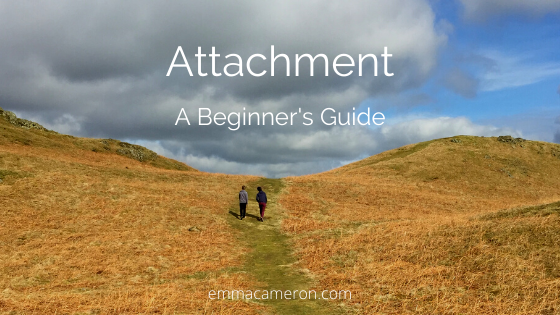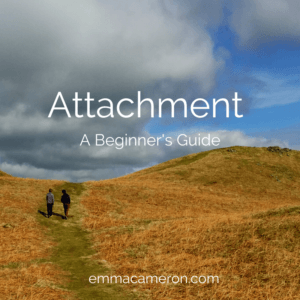
If you’re interested in therapy and/ or self-help, you have probably heard of the term ‘Attachment’. So what is Attachment, why does it matter, and how might it be affecting you and your close relationships? And the question most of us are keen to have answered: Is it possible to change your attachment style? (Quick answer: Yes!)
[And just as a side-note: the word ‘attachment’ in psychology carries different meanings from how the term is used in Eastern spiritual approaches. This blog post is based on psychology.]
Attachment: How Early Relationships Influence Your Mind and Your Later Relationships
Attachment (first developed as a theory by John Bowlby and Mary Ainsworth in the 1950’s) is basically about how our early relationship experiences with our parent(s) influence our psychological development, not just in childhood but often through life. For you as a baby, attachment was about getting your needs met and getting help in managing your emotions. Now you’re an adult, attachment shows up in your whole attitude towards your own experience (experience which includes our sense of self, our relationships, our emotions, our body, and our thoughts).
Attachment is likely to have played a big role in forming your personality (along with other important factors like temperament, genetics and environment). The attachment system is a crucial part of how our brains get built in infancy and early life, and it strongly influences how our minds and relationships continue to function through life.
Your Attachment System Kept You Safe
Humans, like most animals, have the attachment system built-in to our nervous system: it’s a biological necessity. Basically, a young animal is much more likely to survive if it is physically close to its attachment figure (usually a parent). The attachment system makes sure that in times of anxiety, danger or high emotion, the young one will stay connected with their stronger, older, more experienced attachment figure, and will be looked after and protected by them. Your attachment system, in conjunction with your caregivers’ attachment systems, kept you safe.
Attachment Helped You Explore and Grow
When attachment is going well (secure attachment), the young one feels confident that they have a secure base (their attachment person) that they can return to whenever they feel scared or upset. This confidence allows the little one to explore the world, try out new things and playfully make new connections with others. Securely attached kids grow up feeling that life can generally be coped with, and that there’s an exciting, interesting and meaningful world out there for them.
Attachment: a beginner's guide, for anyone interested in therapy & psychology. Share on XCare-Seeking and Care-Giving: The Two Parts to the Attachment System
The two reciprocal roles in the attachment system are the roles of care-seeking and care-giving. Care-seeking can get activated when any kind of threat, physical or emotional, is perceived. (For example, when a baby is frightened by a strange noise, or by a bearded stranger peering into their pram). Care-giving can get activated when a vulnerable loved one is in need. An example would be when a parent’s care-giving system gets activated on hearing their little one’s cry for help, and Mum or Dad rushes to check if everything is okay with the baby, and to give comfort.
Attachment and Your Nervous System
Secure attachment builds the brain networks that regulate your amygdala and other fundamental parts of your brain and nervous system. If you don’t have a well-regulated nervous system, you get easily hyper-aroused (triggered too easily into states of high emotional distress/ overwhelm) and/or hypo-aroused (pulled into states of emotional numbness and depression).
The Parent’s Brain Structures Their Child’s Brain
Neuropsychotherapist Dr Louis Cozolino says, “The parent, early on, is a kind of prosthetic orbital-medial prefrontal cortex [thinking brain]. And the way in which the child has to adapt to the parent, in a sense becomes kind of the architecture of this hierarchical system.”
In simpler language, what this means is that when you were tiny, all those thousands of interactions between you and your Mum/ Dad/ carer were crucial for structuring your young brain. Your parent’s nervous system (which includes their thinking brain and their emotions) was used as scaffolding for your early brain development.
As a baby and young child, you probably had very evident, ‘out there’ emotions which rollercoastered through the day (ever seen a toddler have a full-blown emotional meltdown because their socks are the wrong colour?) Your emotions were red flags activating your attachment system, and your parent’s attachment system. And when a parent’s own attachment system gets activated, their attachment strategies are all-important. The parent’s own attachment strategies will influence how well they’re able to help their child manage its emotions.
And by the way, one interaction isn’t enough to create a child’s attachment style – we’re talking hundreds of repetitions.
There are Four Attachment Categories
Four attachment categories have been identified; one secure and three insecure. All four of them originally develop to help a child survive, based on that child’s particular family context. We originally developed our attachment strategies to help us manage our feelings and our nervous systems in the particular social environment we grew up in. For example, the child who has repeated experience of her mum becoming cold and somewhat distant when the child cries, learns to try not to show her sad or fearful feelings to her mum. This child develops an insecure-avoidant attachment with her mum, which helps preserve their relationship but at the high cost of the child becoming more and more cut-off from her own feelings.
Attachment Styles
You might hear people talk about ‘attachment styles’. This is a shorthand way of saying that most of us seem to have one main strategy that we use. We might not use it all the time, but it’ll come up particularly when we are feeling stressed and under emotional pressure. This main strategy deeply informs our view of the world and our ability to connect with others. Sometimes we may develop more than one attachment strategy, depending on our relationship style with each parent.
In adults, having a secure attachment style is a wonderful basis for living a life that includes fulfilling relationships, work and play. Having one of the three insecure attachment styles tends to lead to more difficulties and disruptions in relationships, as well as more trouble with managing feelings. Insecurely attached people are also more vulnerable to developing PTSD after something traumatic happens to them.
In Part 2 of this series on Attachment, I’ve written in more detail about secure attachment. There I explain how you may be able to develop an earned-secure attachment style even if you never had one as a child. Read about secure attachment here. There’s also lots to say about the three categories that make up insecure attachment. I’ll be writing about insecure attachment in Part 3 (forthcoming).
What’s Your Experience of Attachment?
What does attachment mean in your life? Are you developing an earned-secure attachment style? I’d love to hear your perspectives – just leave a comment below.
Types of therapy that use an Attachment perspective include attachment-based psychoanalytic psychotherapy, AEDP (Accelerated Experiential Dynamic Psychotherapy), Integrative psychotherapy, and Integrative Arts Psychotherapy, amongst others. It’s fine to ask your therapist (or a potential therapist) if they work from an attachment perspective, and how attachment informs their work.
I offer attachment-based therapy online in the UK. Email me at espcameron[at]protonmail[dot]com with a little bit about what you’re looking for help with, and perhaps we can book a free 15-minute phone consultation to discuss if I might be the right therapist for you.
Online Resources:
Feel More Secure Inside with Attachment Based Therapy
Secure Attachment – What Is It And How Do You Get It?
Quiz to help you figure out your attachment style: https://dianepooleheller.com/attachment-test/
Podcast: Therapist Uncensored
Podcast: The Teachers’ Introduction to Attachment
Article: ‘What is ‘attachment’ and how does it affect our relationships?’
Books:
Leslie Becker-Phelps, Insecure in Love: How Anxious Attachment Can Make You Feel Jealous, Needy, and Worried and What You Can Do About It
Sue Johnson, Hold Me Tight: Your Guide to the Most Successful Approach to Building Loving Relationships
Stan Tatkin, Wired for Love: How Understanding Your Partner’s Brain Can Help You Defuse Conflicts and Spark Intimacy
(For therapists) David Wallin, Attachment in Psychotherapy
*Dr Louis Cozolino, interviewed in Therapist Uncensored podcast, episode 89
